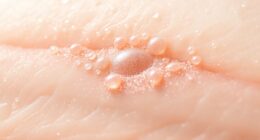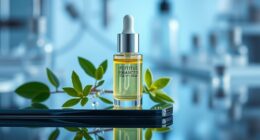When it comes to choosing between natural oils and chemical treatments, consider your hair type and needs. If you have dry hair, nourishing oils like coconut or jojoba can provide moisture and softness. For quick fixes on damaged or colored hair, chemical treatments might be more effective. However, keep in mind the potential for dryness and damage with chemicals. Each option has its pros and cons, and you might find the best choice for you by exploring further.
Key Takeaways
- Natural oils are ideal for moisturizing dry hair and promoting scalp health through deep hydration and nourishment.
- Chemical treatments offer quick fixes for hair texture changes, providing effective solutions for specific concerns like breakage or color maintenance.
- Consider your hair type: nourishing oils suit dry textures, while chemically treated hair may require targeted chemical solutions to maintain vibrancy.
- Be aware of potential allergic reactions with natural oils and possible damage from long-term chemical use that strips natural moisture.
- Personal hair goals and preferences should guide your decision between natural oils for nourishment or chemical treatments for immediate results.

When it comes to hair care, should you reach for natural oils or chemical treatments? The decision often hinges on your hair type and specific needs. Natural oils like coconut, jojoba, and almond oil are great for moisturizing both your hair and scalp. If you’ve got dry hair, these oils can deeply hydrate, leaving your locks soft and manageable. Oils such as cedarwood and clary sage can even stimulate your scalp, promoting hair growth. If dandruff is a concern, consider using soothing oils like chamomile and lavender, which help calm irritation and reduce flakes. Additionally, many essential oils can improve indoor air quality while you pamper your hair. Regular hydration is also crucial for overall health, as it supports kidney function and can promote healthy hair growth.
However, natural oils do have their drawbacks. Their effects mightn’t be as long-lasting as those of chemical treatments, so you might find yourself reapplying more frequently. Additionally, some people can have allergic reactions to certain oils, so it’s always wise to do a patch test first. The consistency of natural products can also vary, which may affect your results. Plus, while many natural oils are cost-effective, some can be pricey or hard to find.
On the flip side, chemical treatments offer quick and effective results. If you need immediate changes in hair texture or want to repair damage, chemical solutions could be the way to go. They offer targeted solutions, using ingredients like sulfates and silicones that clean and style effectively. Chemical treatments also often include ceramides, which strengthen hair structure and help prevent breakage. You’ll find these products widely available, making it easy to find the right one for your needs. Additionally, many professionals recommend using best shampoos for highlighted hair to maintain color vibrancy when using chemical treatments.
But beware; while chemical treatments can be effective, they can also be harsh. Ingredients like sulfates can strip your hair of its natural oils, leading to dryness over time. Additionally, many chemical products raise health concerns due to potential irritation and environmental impact. They can even strip color from treated hair, which is especially concerning for those who dye their hair.
Ultimately, the choice between natural oils and chemical treatments boils down to what your hair needs. If you have dry hair, go for nourishing oils. If you need immediate fixes for damaged or colored hair, chemical options may be better. No matter what route you choose, understanding what your hair needs will help you achieve the best results.
Frequently Asked Questions
Can Essential Oils Be Mixed With Chemical Products Safely?
Yes, you can mix essential oils with chemical products safely, but you need to proceed with caution.
Always read labels to verify compatibility and dilute essential oils with carrier oils to prevent irritation.
Patch test any new blends before full application, and be mindful of potential interactions, especially with photosensitive oils.
Understanding your hair’s needs will help you create effective combinations, but consulting a professional can provide valuable guidance.
How Do I Identify My Hair Type Accurately?
To identify your hair type accurately, start by examining the texture, curl pattern, porosity, and density.
Feel your strands to determine if they’re fine, medium, or coarse.
Next, check your curl pattern using the Andre Walker system, then test your hair’s porosity with a water test.
Finally, assess how thick or thin your hair is to understand its density.
This knowledge helps you choose the right products for your unique hair needs.
Are Natural Oils Suitable for All Hair Types?
Yes, natural oils can be suitable for all hair types, but it’s important to choose the right ones.
For example, coconut oil deeply moisturizes thick hair, while lightweight oils like jojoba work well for straight hair.
You’ll need to experiment to find the best fit for your specific hair texture.
Just remember not to overuse oils, as that can weigh your hair down and lead to greasiness.
How Often Should I Use Natural Oils on My Hair?
Imagine your hair soaking in the nourishing goodness of natural oils, transforming from dull to radiant.
If you’ve got dry hair, you should oil it 2-3 times a week for that luscious hydration. For oily hair, once a week keeps it balanced.
With normal hair, aim for once or twice weekly. Adjust based on your scalp’s needs, and watch your hair thrive with every application, feeling softer and healthier than ever!
Can Chemical Treatments Damage Natural Oils in My Hair?
Yes, chemical treatments can damage the natural oils in your hair. They strip away moisture, leaving your hair dry and brittle.
When you undergo these treatments, the disulfide bonds in your hair get broken, altering its texture and increasing porosity. This means your hair can lose its ability to retain moisture effectively.
To counteract this, consider using natural oils to help restore hydration and maintain balance after chemical treatments.
Conclusion
In the end, choosing between natural oils and chemicals often comes down to your unique hair type and personal preferences. You might find that a nourishing coconut oil transforms your dry strands, while a synthetic serum works wonders for someone else’s oily locks. It’s fascinating how what works for one can sometimes be a complete flop for another. Embrace the journey of discovery; your hair’s needs can change with the seasons, just like your own.
Emma founded Patchology.org with a vision to simplify skincare through the innovative use of patches. With over a decade of experience in skincare blogging, Emma ensures that every piece of content on the site meets the highest standards of clarity and integrity. She loves curating content that makes skincare accessible to everyone.










